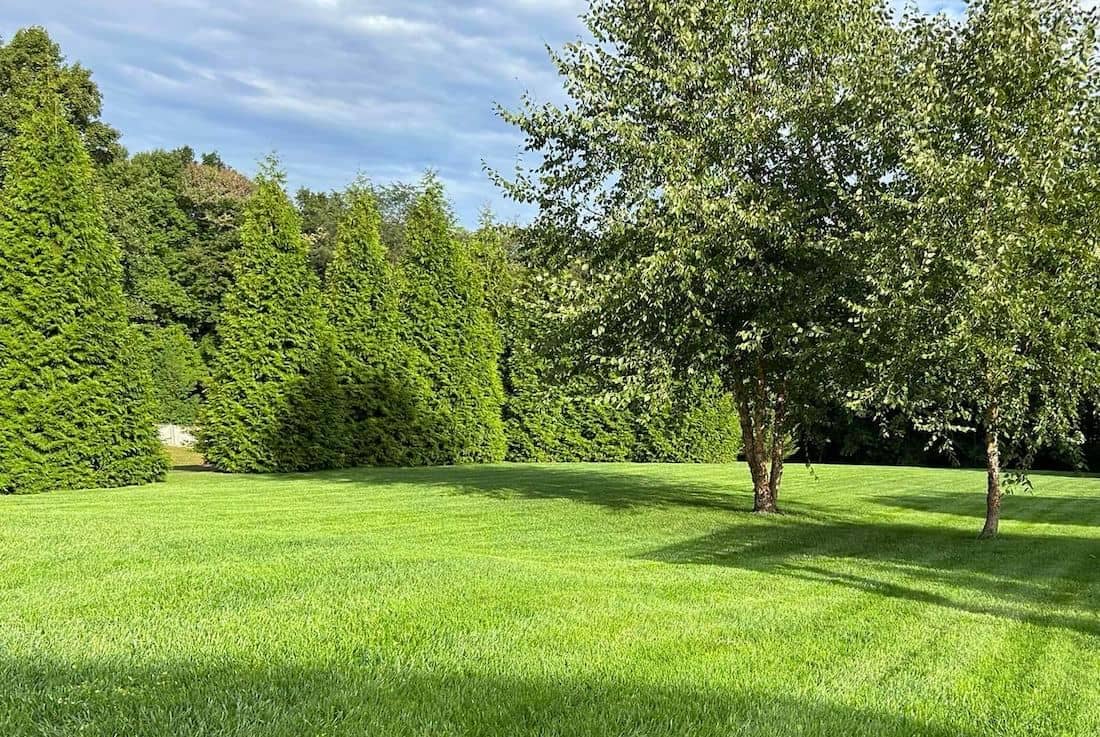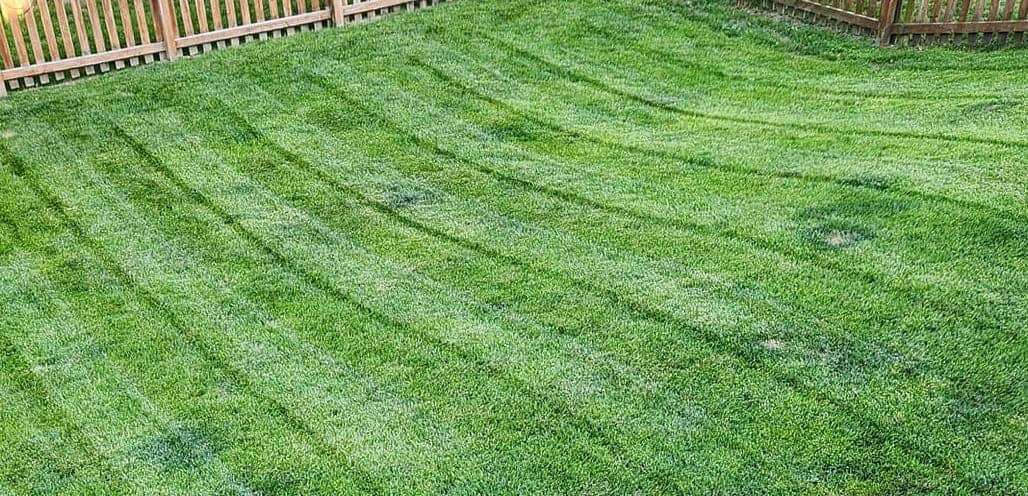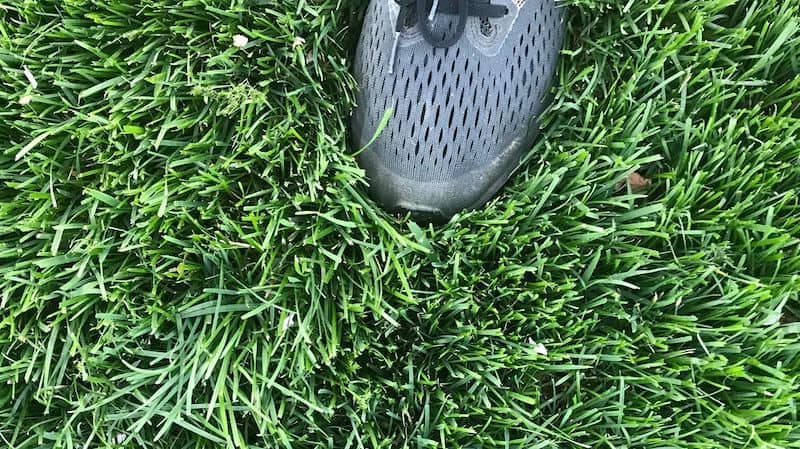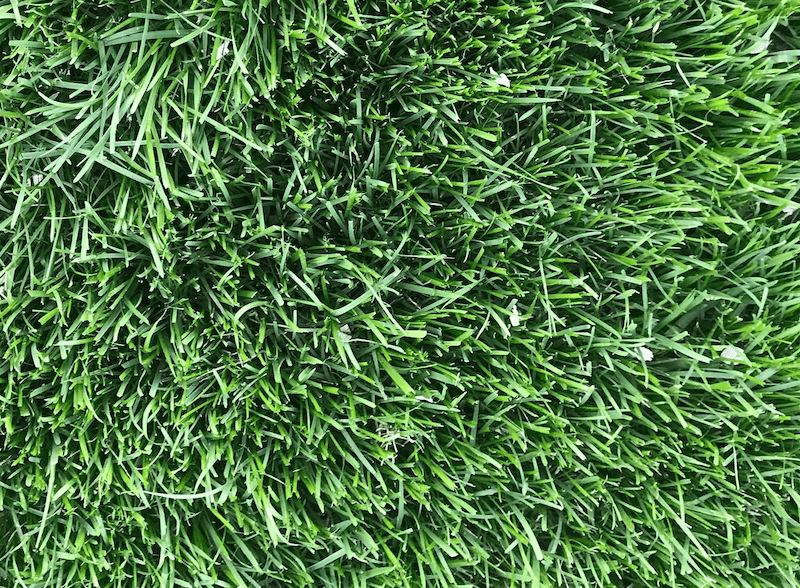In this guide to Tall Fescue, we'll discuss everything from cost to best mowing height while also looking at the pros and cons. By the end, you'll be perfectly positioned to know whether it's the right sod type for you.
What Is Tall Fescue Sod?
Tall fescue sod is a grass we love for its durability. It's a cool-season turfgrass, which means it thrives in chillier weather. Its deep roots let it reach water in droughts, making it a tough option for our yards.
You may wonder, "Why choose sod over seeds?" Sod gives us an instant lawn. We don't wait for seeds to grow. We get a lush, green carpet right away. Tall fescue sod is great for places with full sun to moderate shade. It tolerates heat, too.
Here's what stands out about tall fescue sod:
Hardy: It can take a beating, from foot traffic to hot sun.
Versatile: Fits in many soil types, not too picky.
Disease-resistant: Keeps its green without much fuss.
Our yards will see benefits like:
Less erosion on slopes
Fewer weeds invading
Quicker use of our outdoor space
Tall fescue sod has a coarse texture. The blades are on the thicker side. That makes it feel bouncy under our feet.

Don't forget to prep the soil before laying sod. We need the roots to touch soil, not air pockets. This helps them grab on and get nutrients.
When we care for tall fescue sod right, it rewards us. We're talking modest watering, some fertilizing, and regular mowing. With love, this sod will keep our lawns looking ace.
Key Features and Facts
Tall fescue sod is known for its tough attitude. We're talking about a grass that stands up to a lot. It's like the superhero of lawns. Let's break down what makes this sod so special.
Climate Tolerance: First up, we can plant this stuff in a bunch of different places. It's cool with both heat and cold, which means it's super adaptable.
Durability: Next, we've got to talk about how tough it is. Tall fescue is one strong grass. It can handle our footsteps without getting all bent out of shape.
It resists diseases.
It doesn't get scared off by insects.
It just keeps growing.

Root System: The roots go deep with this one. They dive down to grab every drop of water and nutrients. That means it stays greener longer, even in dry spells.
Feature | Benefit |
Deep Roots | Grabs more water |
Disease Resistant | Fewer brown spots |
Heat Tolerant | Stays green in summer |
With all these features, it's clear why we like tall fescue sod. We get a lawn that's tough, resilient, and doesn't need a ton of babysitting. Now that's a win in our book!
When to Lay Tall Fescue Sod
Timing is crucial when laying tall fescue sod. We want to ensure that the sod has the best chance to thrive. Let's look at the soil and light conditions we need for success.
Soil Conditions
The dirt's gotta be just right. Before we toss down fresh sod, we ensure the soil temperatures are between 50°F and 65°F. Why? Because tall fescue roots like it cool but not cold. A simple soil thermometer can save us a headache later.
We also check soil moisture. It should be damp, but not soggy. Think of a well-wrung sponge. If soil crumbles like a cookie, it's too dry. If there's pooled water, it's party time for fungi, not fescue.
Light Conditions
Now let's talk sun. Full sun to partial shade works best for tall fescue sod. We're aiming for about 4 to 6 hours of sunlight daily.
Level Up Your Lawn Skills
Once per week we'll send you an interview from someone who has mastered the art of lawn care.
If we've got too much shade, the sod might struggle and throw a fit like a toddler without a nap. If it's scorching, as if the sun's got a magnifying glass on our sod, we'll have another problem on our hands. Keeping it balanced is key.
Where to Buy Tall Fescue Sod
When we're on the hunt for tall fescue sod, we've got some solid options. Our first stop? Local garden centers or nurseries. They often have fresh sod that's adapted to our climate. It's a good idea to support these local businesses, and we can get some great advice from the experts there.
Online retailers are another choice. They've got a variety of options and can deliver right to our doorstep. Just make sure to check the reviews and go for reputable sellers.
Here's a quick list to check out:
Local Nurseries: Get personalized service.
Garden Supply Stores: Find a wide selection.
Online Marketplaces: Look at customer ratings.
Farm Direct: Maybe save a buck or two.
Prices can vary, so we should shop around and compare.
We'll want to consider the delivery options, too. Sod can be heavy, and the cost to deliver can add up. Some places offer free delivery if we order enough, which can be pretty sweet.
Type of Store | Pros | Cons |
Local Nursery | Local expertise | Might be pricier |
Garden Center | Good selection | Limited delivery options |
Online Retailer | Convenient | Shipping can be costly |
Farm Direct | Cost-effective | Limited selection |
And remember, the fresher, the better. We don't want to spend our cash on sod that's past its prime. Let's make sure it's green and ready to grow before we take it home.
A Note on Measurement: Rolls, Pallets and Square Feet
When we talk about buying tall fescue sod, we deal with rolls, pallets, and square footage. Let's make sense of this.
Rolls are the individual pieces of sod. Each roll is usually about 10 square feet. But sizes can vary. Check with your supplier.
Pallets are groups of rolls. They can cover anywhere from 400 to 500 square feet. This also varies by supplier. A typical pallet holds about 40 to 50 rolls.
Now, let's break it down in a table:
Unit | Size Range | Coverage |
Roll | ~10 square feet | 1 Roll |
Pallet | 400-500 sq feet | 40-50 Rolls |
We measure our lawn area in square feet. To figure out how much sod you need, measure your lawn's length and width. Multiply them. Now you've got your square footage.
Here's a quick list to remember:
Measure your lawn in square feet (length x width).
One roll typically equals 10 square feet.
One pallet covers around 400-500 square feet.
There you have it! Now we're ready to choose the right amount of tall fescue sod. With a little math, we'll have that lush lawn in no time.
How to Choose a Contractor to Install New Sod
When we're looking for a tall fescue sod installation company, we want the best value for our money. Here's how to dig into the numbers and make a smart choice.
Installer Quotes: Prices, Estimates, and the Actual Cost
Getting the perfect lawn isn't just about the green grass. It's also about the greenbacks, our cash. Estimates can be slippery. We might see numbers like "$0.50 per square foot" tossed around. But the bottom line includes more. Here's a quick breakdown:
Base Price: This is the starting point, often the per square foot rate.
Prep Work: Think soil tests, old lawn removal. Extra work = extra cash.
Installation Costs: Not just laying sod. It's the cutting, fitting, and sometimes, the aftercare advice.
Travel Fees: If they're coming from far out, we could be covering that gas.
Miscellaneous Fees: Like for extra services. Aeration, anyone?
Actual Cost Table:
Service | Estimated Cost Range ($) |
Base Price | 0.30 - 0.70 per sq. ft. |
Prep Work | 50 - 200 |
Installation | 150 - 300 |
Travel Fees | 25 - 100 |
Misc. Fees | 50 - 100 |
Quotes can be enticing, but we need to read between the lines. It's smart to ask for a detailed quote. That means pressing for specifics on each line item. It helps us avoid surprises when the final invoice comes.
Key Characteristics of Tall Fescue
We're focusing on what makes tall fescue stand out. Let's get into the nitty-gritty.
Durability and Resilience
Tall fescue is tough. It handles foot traffic like a champ. This grass keeps it together when others would fall apart. It's perfect for yards that get a lot of play and activity.
Dormant Season
When it's cold, tall fescue takes a nap. Expect it to slow down and brown out when the temperature drops. But don't worry, it's not dead. It’s just taking a break and will bounce back when it warms up.
Drought Tolerance
We've got some good news here. Tall fescue can handle dry spells. It’s got deep roots that find water way down in the soil. So, even when the rain forgets to fall, this grass hangs in there.
Cold Tolerance
Here's the scoop on cold: tall fescue can take it. It doesn't bail at the first frost. Instead, it sticks around, making it a solid choice for cooler climates. Frosty mornings? No problem for our grass.
How to Care for Tall Fescue
Caring for tall fescue means a bit of work. We've got to keep it clean, watered, and well-fed. Let's get into the specifics.
Cleaning and De-Thatching
Firstly, keeping our tall fescue clean is a must. It's like brushing our teeth; we do it regularly to prevent decay. Similarly, de-thatching is important. When thatch builds up, it stops nutrients and water from reaching the roots. Aim to de-thatch yearly.
Core Aerating
Our grass needs to breathe! Aerating involves pulling out small cores of soil, and it lets air and water get down to the roots. This is like a mini spa for our lawn. We should aerate our tall fescue lawn every few years.
Mowing
Let's talk mowing. We've got to keep the grass at the right height—not too short. The ideal height for tall fescue is about 2.5 to 3 inches. Regular mowing also encourages thickness and health.
Watering
Watering is essential, and timing is key. We should give our tall fescue about 1 to 1.5 inches of water per week. Early morning is the best time for watering to reduce evaporation and disease risk.
Fertilizing
Fescue loves food. We need to feed it right with the proper fertilizer. Applying a balanced fertilizer in the fall and spring will keep our grass vibrant and strong.
Controlling Pests
Lastly, we've got to protect our lawn from invaders. Grubs and other pests can be a nightmare. Regularly checking for pests and using appropriate treatments will keep our tall fescue safe.

Pros & Cons of Tall Fescue Sod
Pros
Tough as Nails: Tall fescue is one tough cookie. It can handle a lot of foot traffic, so it's perfect for our yards where we play and hang out.
Thirsty? Not so much: This grass is not a big drinker. It can survive dry spells without a meltdown. We can save on water bills.
Cold? What cold? It laughs in the face of chilly weather. Tall fescue remains green when other grasses go brown.
Goes easy on the mower: It grows upright more than spreading out. We don’t have to mow as often.
Cons
Summer's a Bummer: When the heat waves hit, tall fescue can struggle. High temps can make it go "ouch!"
Not a Smooth Operator: The blades are kind of coarse. This means it's not the softest for bare feet.
Invites Some Unwanted Guests: Sometimes, it can attract some pesky bugs and diseases. Nobody likes uninvited guests.
Patchiness Can Be a Problem: If it gets damaged, it doesn't self-repair as well as some other sods. We might have to patch things up ourselves.
Frequently Asked Questions
We've got the skinny on keeping that tall fescue of yours looking great. Let's dive into those burning questions you might have.
What's the ideal fertilizing routine for maintaining lush tall fescue grass?
We recommend feeding your tall fescue sod a balanced fertilizer in early spring and fall. Remember, too much fertilizer can burn the grass, so stick to the recommended rates on the product label.
What should I be aware of before choosing tall fescue for my lawn?
Know that tall fescue loves cooler temperatures and thrives in moderate climates. It's pretty tough and can handle some foot traffic. But, it might need a little shade now and then during those extra hot months.
How frequently should I water my new fescue sod, especially during initial growth?
When we first lay the sod, it's game time for our sprinklers—twice a day for the first couple of weeks. After that, we ease into a more chill schedule, maybe once or twice a week, giving it a good soaking each time to foster deep roots.
What are some shade-tolerant tall fescue grass varieties?
Some tall fescue grass varieties known for their shade tolerance include:
'Creeping Red'
'Chewings'
'Hard'
'Sheep'
These varieties can grow well even in areas with limited sunlight.
Tall Fescue versus other types of sod
- Tall Fescue vs. Bermuda comparison →
- Tall Fescue vs. Buffalo comparison →
- Tall Fescue vs. Zoysia comparison →
- Tall Fescue vs. Kentucky Bluegrass comparison →
- Tall Fescue vs. Perennial Ryegrass comparison →
- Tall Fescue vs. St. Augustine comparison →
- Tall Fescue vs. Centipede comparison →
- Tall Fescue vs. Fine Fescue comparison →
- Tall Fescue vs. Bahia comparison →
Level Up Your Lawn Skills
Once per week we'll send you an interview from someone who has mastered the art of lawn care.

